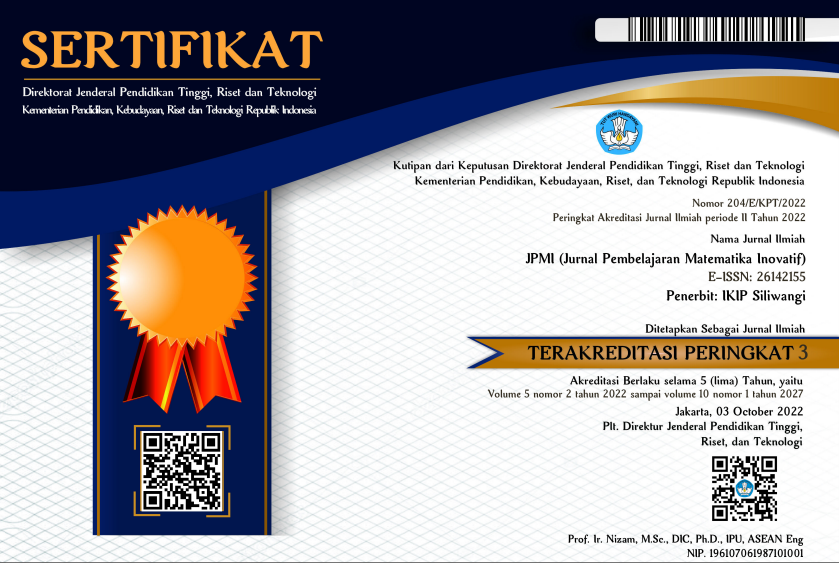Analisis komunikasi matematis siswa pada materi relasi dan fungsi berdasarkan SOLO taxonomy ditinjau dari minat belajar siswa
DOI:
https://doi.org/10.22460/jpmi.v8i1.26411Keywords:
Mathematical Communication, Relation and Function, Learning Interest, SOLO TaxonomyAbstract
The objective of this research is to describe students’ mathematical communication in terms of student’s learning interests based on the SOLO Taxonomy level. The research method is a descriptive qualitative study conducted at SMPN 35 Pekanbaru grades VIII. The subject of this research is 8 students in grades VIII with high and medium learning interests. The research instruments used are a learning interest questionnaire and a mathematical communication test. The analysis consists of three stages: data condensation, displaying data, and drawing the conclusion. The research concludes there is no significant difference in students’ mathematical communication levels between medium and high learning interest students. Students with medium and high learning interests are on the multi-structural level. However, students with high learning interests put more effort into solving mathematics problems than students with medium learning interests. Therefore, efforts are needed, such as using the interactive learning model and media which increase the student’s learning interest to develop students’ mathematical communication ability.
References
Demir, M., Zengin, Y., Özcan, Ş., Urhan, S., & Aksu, N. (2023). Students’ mathematical reasoning on the area of the circle: 5e-based flipped classroom approach. International Journal of Mathematical Education in Science and Technology, 54(1), 99–123. https://doi.org/10.1080/0020739X.2022.2101955
Hidayat, S. R., Ermawati, D., & Rondli, W. S. (2023). Analisis kemampuan komunikasi matematis siswa sekolah dasar. Edukatif: Jurnal Ilmu Pendidikan, 5(2), 1677–1684. https://doi.org/10.31004/edukatif.v5i2.5478
Meriyana, Tandiayuk, M. B., & Paloloang, B. (2016). Profil berpikir siswa kelas VIII SMP dalam menyelesaikan soal cerita aljabar berpandu pada taksonomi solo ditinjau dari tingkat motivasi belajar matematika. Aksioma, 5(2), 170-181. https://doi.org/10.22487/aksioma.v5i2.130
Mukuka, A., Balimuttajjo, S., & Mutarutinya, V. (2020). Applying the solo taxonomy in assessing and fostering students’ mathematical problem-solving abilities. Proceedings of the 28th Annual Conference of the Southern African Association for Research in Mathematics, Science and Technology Education, 104–112. https://www.researchgate.net/publication/338778457_APPLYING_THE_SOLO_TAXONOMY_IN_ASSESSING_AND_FOSTERING_STUDENTS'_MATHEMATICAL_PROBLEM-SOLVING_ABILITIES
Mullis, I. V. S., Martin, M. O., Foy, P., Kelly, D. L., & Fishbein, B. (2020). TIMSS 2019 international reports in mathematics and science. TIMSS & PIRLS International Study Center. https://timss2019.org/reports/index.html
National Council of Teachers of Mathematics (Ed.). (2000). Principles and standards for school mathematics. National Council of Teachers of Mathematics.
Nuron, N., Sopandi, D., & Sari, V. T. A. (2018). Analisis kemampuan komunikasi matematis dan minat belajar siswa SMP pada materi segitiga dan segiempat. JPMI (Jurnal Pembelajaran Matematika Inovatif), 1(4), 617–622. https://doi.org/10.22460/jpmi.v1i4.p617-622
Sa’id, I. A., Pambudi, D. S., Hobri, Safik, M., & Insani, K. (2021). Development of mathematics learning tools with Realistic Mathematics Education-Jumping Task (RME-JT) and its effect on the mathematic communication skills. Journal of Physics: Conference Series, 1839(1), 012018. https://doi.org/10.1088/1742-6596/1839/1/012018
Setiyani, S., Putri, D. P., Ferdianto, F., & Fauji, S. H. (2020). Designing a digital teaching module based on mathematical communication in relation and function. Journal on Mathematics Education, 11(2), 223–236. https://doi.org/10.22342/jme.11.2.7320.223-236
Setyowati, S., Cholily, Y. M., & Azmi, R. D. (2020). Analysis of mathematical communication capabilities in completing problems in matrix materials based on solo taxonomy. Mathematics Education Journal, 4(2), 166-176. https://doi.org/10.22219/mej.v4i2.12832
Silwana, A., Subanji, S., Manyunu, M., & Rashahan, A. A. (2021). Students’ responses leveling in solving mathematical problem based on SOLO taxonomy viewed from multiple intelligences. Indonesian Journal on Learning and Advanced Education (IJOLAE), 3(1), 1–16. https://doi.org/10.23917/ijolae.v3i1.10528
Slameto. (2010). Belajar dan faktor-faktor yang mempengaruhinya. PT Rineka Cipta.
Tambalitan, P. C., & Aseng, A. C. (2023). Kajian hubungan motivasi dan minat belajar siswa SMA pada mata pelajaran ekonomi. Journal of Education Research, 4(4), 2632-2637. https://doi.org/10.37985/jer.v4i4.549
Teledahl, A. (2017). How young students communicate their mathematical problem solving in writing. International Journal of Mathematical Education in Science and Technology, 48(4), 555–572. https://doi.org/10.1080/0020739X.2016.1256447
Turmuzi, M., Wahidaturrahmi, W., & Kurniawan, E. (2021). Analysis of students’ mathematical communication ability on geometry material. Edumatica : Jurnal Pendidikan Matematika, 11(1), 50-61. https://doi.org/10.22437/edumatica.v11i01.12394
Yuliani, D., & Vioskha, Y. (2022). Kemampuan komunikasi matematis siswa ditinjau dari minat belajar siswa SMP Negeri 32 Pekanbaru. Seminar Nasional Paedagoria, 2(1), 149–154. http://journal.ummat.ac.id/index.php/fkip/article/view/10126
Downloads
Published
Issue
Section
License

This work is licensed under a Creative Commons Attribution-ShareAlike 4.0 International License.
The author is responsible for acquiring the permission(s) to reproduce any copyrighted figures, tables, data, or text that are being used in the submitted paper. Authors should note that text quotations of more than 250 words from a published or copyrighted work will require grant of permission from the original publisher to reprint. The written permission letter(s) must be submitted together with the manuscript.
















